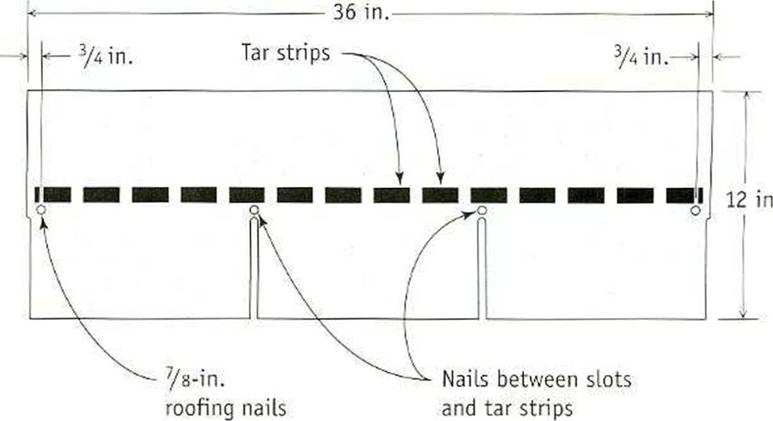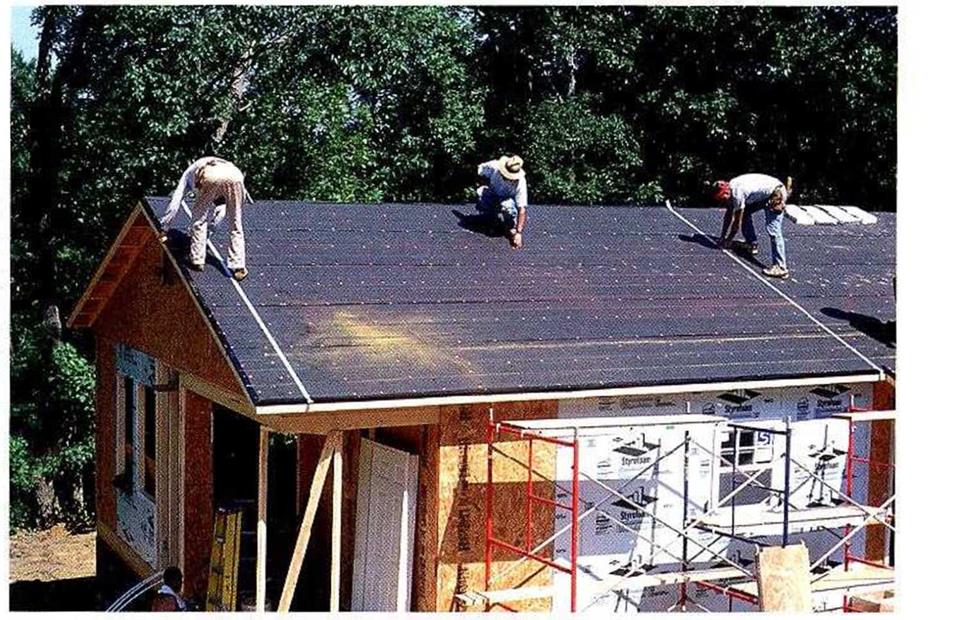Materials ESTIMATES FOR A ROOF
DETERMINING THE QUANTITY of materials needed to cover and shingle a roof is rather easy. First, measure the roof to determine its square footage. Add the width of both sides of the roof and multiply that number by the length of the roof. Let’s look at an example: A roof with an overall width of 28 ft. and a length of 46 ft. has a total area of 1,288 sq. ft., which I’d round up to 1,300 sq. ft.
Figure felt paper first. The first material you will need is felt paper. The coverage you can obtain from a roll of felt paper varies, but it’s often 300 sq. ft. (to make sure, ask your building – materials supplier). Divide 1,300 sq. ft. by 300 sq. ft. for a total of 4.33 or 4Уз rolls. Buy five rolls of felt paper, because you’ll need the extra to compensate for overlap and to seal around the plumbing vents.
Shingles come in bundles and are ordered by the square. One bundle of standard-size shingles covers 33.3 sq. ft. Three bundles cover 100 sq. ft.
(10 ft. by 10 ft.), which is called a square. It takes 13 squares (39 bundles) to cover a l,300-sq.-ft. roof. Order at least two extra bundles to make up for the ridge cap, the valley lap, and waste.
In addition to the shingles, you’ll also need a ridge vent. Measure the length of the ridge to determine the size you’ll need. Depending on the manufacturer’s recommendations, vents can extend all the way across the ridge or to within 2 ft. of the roof’s edge at each end.
Don’t forget the nails. Buy 7/s-in. roofing nails for the shingles (about 1 lb. per square) anc ІУИп. nails for the ridge vent (about Vz lb.). Buy cuil nails if you are using a pneumatic nailer. If the eave overhangs will be exposed, buy 2 lbs. of Уз-in. roofing nails; longer nails that penetrate the roof sheathing are unsightly. You’ll also need about 5 lbs. of plastic-head roofing nails to hold the felt paper in place on a roof this size. Add a tube or two of asphalt caulk to cover any exposed nails and to seal around the plumbing vents.


shingles relied more heat than dark ones do. For this reason, people living in the southern part of the United States tend to prefer light – colored shingles. People living further north often select darker shingles.
With some simple layout, your shingles can look like a professional installed them. Poorly laid shingles may keep out water, hut they just don’t look appealing. Admittedly, not many people visit your home just to see whether your shingle pattern is pleasing to the eye, hut good workers lake pride in doing things right. When 1 was framing tract houses (500 at a time), I knew roofers who could start in one
corner and shingle an entire roof without
о
snapping a chalkline and do a neat, proper job. That’s skill. The rest of us need to snap a few lines to keep the materials oriented correctly.
BASIC MEASUREMENTS. Before snapping a chalkline for the first shingle course (the starter course), determine the distance the shingles will extend beyond the drip edge.
11 ere in Oregon, shingles typically lap over the edge by about V: in. I worked on houses in Georgia where the shingle overhang was about 2 in. T hey drooped in the hot sun and provided the roof with a nice-looking detail. Just be aware that a large shingle overhang presents a greater surface area to heavy winds,
|
|||
|
|||
|
|
||








Leave a reply